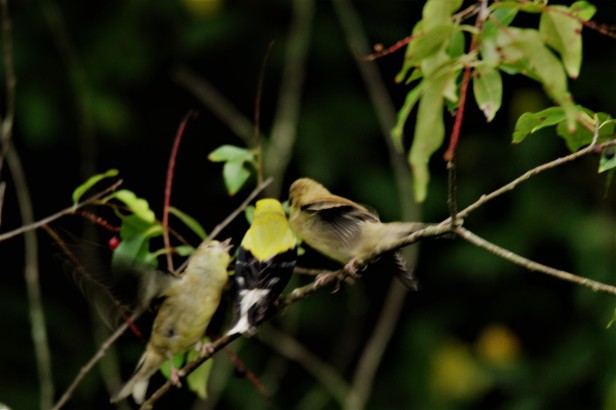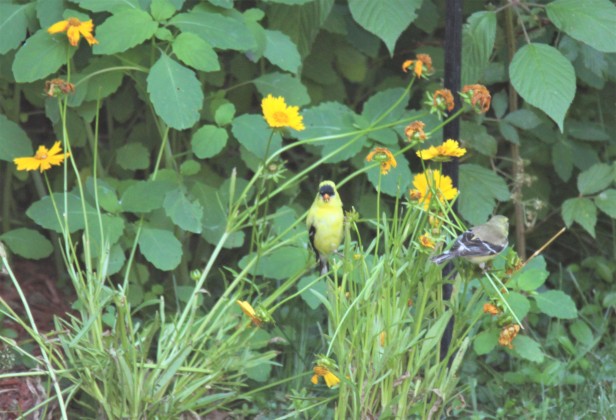If you have been reading my blogs, you know that we have birds that remain in our area all year long and birds that migrate. We have birds that visit for the winter, like the Dark-eyed Juncos, and those that stay and have babies in the summer. We also have birds that just pass-through Western Mass on the way to and from their breeding grounds. I decided to start the spring series with the finches, specifically, the American Goldfinch. There are 9 birds in the finch family that we could see locally. In the winter, we could see Common Redpolls. I have yet to see the other winter finches myself, which include the Pine or Evening Grossbeaks and the Red or White-winged Crossbills. The 2 less common finches that arrive here in the spring are the Pine Siskin and the Purple Finch. We get to enjoy House Finches and Goldfinches year-round. You can see and hear some of these finches on my Robin’s Nest page posts!
I chose the Goldfinch for 2 reasons. I started bird watching as a distraction from my own empty nest after my son went to college. I saw a gorgeous male Goldfinch and thought I had seen some rare parakeet or something. I was hooked. I bought a book. Imagine my surprise when I found out how common this beautiful bird was and that I had just never noticed them before! The second reason I chose this bird to start the spring series is that many people on the bird sights think that they ARE seeing spring migrants when they see Goldfinches. This is because a lot of songbirds will molt. Molting is what happens when birds replace their old worn-out feathers with new ones. They can molt also molt in the fall for winter camouflage, when they go from non-breeding to breeding status, and in the spring to look shiny and new to attract mates. You can learn more about molting on my Resources page.
All Goldfinches are small yellow birds with black wings with white wing bars. They will all look rather drab in the winter to blend in with their surroundings. The non-breeding female will keep her all-over greenish-brown shade of yellow year-round. In the spring, the non-breeding males will have a tannish back and a yellow throat or “collar” and a brownish beak. The breeding females look like the non-breeding male, but they will have an olive-colored back and a pink beak, or “bill”. The breeding males are spectacular with their bright yellow plumage, black caps on their heads and bright pink-orange beaks to attract the females. All but the non-breeding females will have a white rump and pinkish-orange legs. They all have short, cone-shaped beaks and small, black eyes.
These birds live in forests and shrubs all over Western Mass. You can see them in parks, farmlands, orchards, and suburban yards. Goldfinches like to eat flowers and seeds for the most part, with an occasional insect. They will readily come to feeders and will eat the Nyjer seed or thistle, sunflower seeds, safflower seeds and suet. They are neat to watch because they can use their beaks alone to get the seeds out of the shells. My Goldfinches will also eat peanuts, but as a last resort. As I shared in my Valentine blog, American Goldfinches do not mate for life, or even a season. The female will often mate with a couple males. The pairs will build a cup-shaped nest of grass in a tree or shrub, concealed by leaves. They line it with thistle down, so I like to provide nesting material like the Best Nest Builder for them. They will raise 1 or 2 broods between June and September, later than other birds. Each brood will have 4-5 white eggs with reddish brown spots on them.
American Goldfinches are social creatures and stay in flocks. That being said, I have NEVER seen the numbers I have seen this past month. I have had groups up to 100 and they would empty my feeder in a couple of hours. It was almost as if groups WERE migrating, and many people were experiencing this same phenomenon in their own yards. I shared a video and audio of one flock on my Meet Today’s Birds page on February 4th. These birds are prolific singers and have such pretty calls and songs! As I am typing this, I am listening to the 25 or so Goldfinch chirping and singing on my deck feeders. I taped them for you! I included some pictures and an earlier audio below so you will be ready to identify these beautiful birds in your yards. As always, I hope you subscribe and comment. Thanks! Robin 😊




Eating Seeds/Flowers



Great information. Thanks!
LikeLiked by 1 person
Aren’t they beautiful!?
LikeLike
Love birds, thank you so much for sharing this.
LikeLiked by 1 person
You are so welcome!
LikeLike
The gold finches are one of my favorite birds. They are at my feeders all year. I love it when the males yellow and black feathers begin to appear again in the spring. Great post.
LikeLiked by 1 person
Thank you! I was just watching about 60 of them at my feeders!
LikeLiked by 1 person
You are welcome. I have seen a lot of them, but not near what you are seeing. Keep enjoying those beauties.
LikeLiked by 1 person